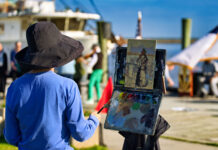
In a current show of pieces by New York City artist Tony Winters, the focus is on the emotional content in a scene. This can result in dramatic colors and interpreted atmosphere.

Detail of “Perimeter Trail Sewanee”
In the detail of “Perimeter Trail Shawnee” shown here, Winters’s color sense is on full view. Winters says, “This is the very heart of that painting. It’s where a single shaft of sunlight has poked through the tree canopy to illuminate a fallen sandstone ledge. Since the environment is a woodland interior, where almost everything is in shadow, the challenge is to let the few sunlit spots have drama and contrast without losing their color. In this location the vertical surfaces of the cliff were reflecting the blue of the sky, while the yellowish afternoon sun was hitting the horizontal ledge.”

Plein air study for “Perimter Trail Swanee,” by Tony Winters, oil, 8 x 10 in.
Adams continues, “I try to identify the two or three main lighting effects in a scene and intensify them at the focal point of the painting. Here, the cool reflected lights from the sky are contrasted with the warm sunlight. All the life forms that inhabit this environment on the forest floor — flowering plants, fungi, insects, snails, salamanders, and many more — have evolved to live in the shade. Only the over-arching trees receive full sun. In the summer growing season they quickly leaf out to capture the sunlight for their own growth, and cast the rest in dappled light and shade. So I liked how this small, moving spot of sunlight captured and symbolized the way of life here.”

Study for “Purple Haze”

“Purple Haze,” by Tony Winters
Winters executes studies en plein air, then paints larger pieces in the studio. He considers the plein air work crucial. “The big part of plein air is getting the emotional content,” he says. “It’s a chance to tune in to the dramas that are going on, the ant carrying the leaf, the bird looking for food. It’s what makes it different from working from a photo. Photography is great for linear information. But spending the time and letting the place work on your senses, that is the big reason why you want to be a landscape painter.”

Lay-in for “Aerie.”

“Summer Clouds — View Toward Cowan Tunnel,” by Tony Winters, oil, 16 x 20 in.
Not everyone would see the spectrum of color in the stones and vegetation the way that Winters sees and expresses it. “For me color is emotional, and I always try to remember that and not be a slave to what is there,” he says. “I use what is there to help express emotions, and I hope that other people respond to it in the same way. We are animals, and we all react to colors in a specific way. Insects go to certain colors. I try to achieve the effect that color has on me. I try to do things on the painting that the scene does to me emotionally.”

“Stone Door of Savage Gulf,” by Tony Winters, oil, 18 x 36 in.
“Sewanee Trails and Coves,” paintings of the Cumberland Plateau, will be on view at Sewanee’s Edward Carlos Gallery through November 4. Winters received his B.A. degree in Fine Arts from Sewanee: The University of the South and was a recipient of the John B. McCrady Award in the Fine Arts.




